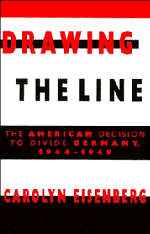Book contents
- Frontmatter
- Contents
- Preface and Acknowledgments
- Germany – Occupation Zones, 1945
- Introduction: Private Polowsky's Oath
- 1 Plans
- 2 Making Peace
- 3 The Limits of Reform: The U.S. Zone
- 4 A Fragile Friendship
- 5 The Russian Challenge
- 6 Bizonal Beginnings
- 7 The Doctors Deliberate
- 8 Marshall's Medicine
- 9 A Separate State
- 10 Cold War Germany
- 11 Winning
- Conclusion: The American Decision to Divide Germany
- Bibliography
- Index
5 - The Russian Challenge
Published online by Cambridge University Press: 07 October 2009
- Frontmatter
- Contents
- Preface and Acknowledgments
- Germany – Occupation Zones, 1945
- Introduction: Private Polowsky's Oath
- 1 Plans
- 2 Making Peace
- 3 The Limits of Reform: The U.S. Zone
- 4 A Fragile Friendship
- 5 The Russian Challenge
- 6 Bizonal Beginnings
- 7 The Doctors Deliberate
- 8 Marshall's Medicine
- 9 A Separate State
- 10 Cold War Germany
- 11 Winning
- Conclusion: The American Decision to Divide Germany
- Bibliography
- Index
Summary
The operation of German central agencies would have militated against zonal boundaries and served to break down exclusive Soviet control of one of the largest and most important German areas. Within it the Soviet Military Government has thrown its vigorous support to the German Communist Party.
(Robert Murphy, February 24, 1946)I think we should guard against undue optimism about central agencies serving to break down exclusive Soviet control in Soviet zone.
(George Kennan, March 6, 1946)During early 1946 the Soviets became less cooperative. After completing a Level of Industry plan with the Allies, they backed away from an agreement to institute an export–import program for Germany as a whole. More dramatically, they tightened political control of the eastern zone by forcing the merger of the Socialists and Communists into a new Socialist Unity Party (SED). Together with the eastern labor movement (FDGB), the party asserted the special interests of the German proletariat and agitated for a more ambitious policy of industrial expropriation.
Although disappointed, leaders of U.S. Military Government viewed these developments as of a piece with the impediments that the French regularly, and the British sporadically, had offered to the Allied project. Whereas previously, they had rated the Russians as the most forthcoming of the occupying powers, by the spring they had become quite critical. Yet within Military Government, there was also a feeling that the Soviet Union's interests had been needlessly thwarted, especially with regard to the uncertain status of the Ruhr–Rhineland. And there was a continuing confidence that with unification, the worst Soviet behaviors would be mitigated.
- Type
- Chapter
- Information
- Drawing the LineThe American Decision to Divide Germany, 1944–1949, pp. 200 - 232Publisher: Cambridge University PressPrint publication year: 1996



